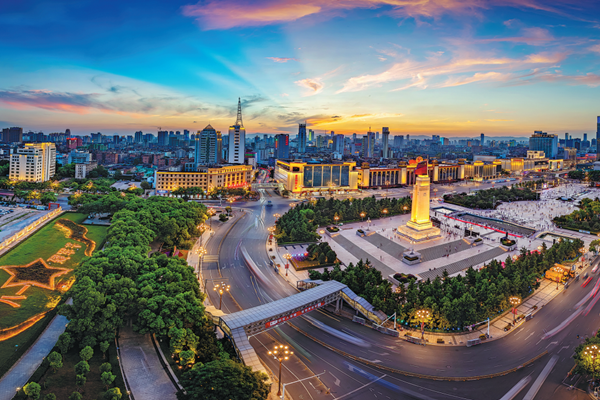Jiangxi aims to lead central region's rise

Bayi Square in Nanchang, capital of Jiangxi province, is named after Aug 1, the date of the Nanchang Uprising in 1927. On that day, the Communist Party of China initiated its first military resistance against Kuomintang counterrevolutionaries. The date has been designated to commemorate the establishment of the People's Liberation Army. PHOTO PROVIDED TO CHINA DAILY
Fueled by revolutionary spirit, province looks to be a model for inland areas via its reform and opening-up efforts
Editor's note: This year, the Communist Party of China is celebrating the 100th anniversary of its founding. China Daily is publishing a series of stories looking at the tremendous changes that have occurred in provinces, autonomous regions and municipalities under the leadership of the Party. They also include stories of the people and places that have left indelible marks in the Party's path to glory.
Jiangxi province will strive to set an example in the high-quality development of old revolutionary base areas and take the lead in promoting the rise of China's central region, said Liu Qi, secretary of the Jiangxi Provincial Committee of the Communist Party of China.
Liu said in an interview with China Daily that Jiangxi will "draw a new picture of reform and development in the new era" as this year marks the 100th anniversary of the founding of the CPC and the start of the country's 14th Five-Year Plan period (2021-2025).
"Looking back at the 100 years of glorious history of the CPC, Jiangxi has made great sacrifices and important contributions to the Chinese revolution," he said.
Famous for its historic ties to the Party, Jiangxi is known as the cradle of the Chinese revolution, the People's Republic of China and the Red Army-the predecessor of the People's Liberation Army-as well as the birthplace of the Chinese workers' movement.
Jiangxi has fostered the Jinggangshan spirit that values faith, perseverance, reason and the people. This spirit has been passed down over time and has inspired generations.
Jinggangshan, a county-level city, was officially removed from the poverty list in February 2017, becoming one of the first in the nation to be taken off it.
During a visit to Jinggangshan before the 2016 Spring Festival, President Xi Jinping, also general secretary of the CPC Central Committee, said, "The most precious heritage of the Jinggang Mountain period (the late 1920s, when a key CPC force led by Mao Zedong was based there) is the Jinggang Mountain spirit, which transcends the limits of time and space."
While touring Nanchang, the provincial capital, in 2019, Xi called on the province to set an example for others by speeding up the high-quality development of its old revolutionary bases and vie to head efforts to promote the emergence of the central region.
Liu said that under the guidance of the Xi Jinping Thought on Socialism with Chinese Characteristics for a New Era, Jiangxi will fully implement the spirit of Xi's important speeches during his inspection visits to Jiangxi.
"By studying Party history, we will inherit the Red gene, gather the strength to forge ahead and promote high-quality leapfrog development in the province," he said.
Development
The growth rate of the main economic indicators in Jiangxi, which is situated at the lower middle reaches of the Yangtze River in the central part of southeast China, remained among the front-runners in China in the past five years, according to a proposal for the province's development blueprint in the 14th Five-Year Plan period.
In the following five years, Jiangxi's growth potential will be fully realized, and the province will work to ensure those indicators continue to grow so that it retains its ranking, the document said.
Liu said that Jiangxi will be built into a beacon of reform and opening-up in inland areas in the new era.
The province will focus on developing competitive industries such as aviation, electronic information, equipment manufacturing, traditional Chinese medicine, new energy, new materials and modern agriculture, Liu said.
"We will also make greater efforts to build a new pattern of development, including comprehensively modernizing the industrial and supply chains," he said.
Jiangxi will also aim to push reform and opening-up to a higher level, Liu said.
The province will develop the inland open economic pilot zone with high standards and fully integrate itself into the developments of the Belt and Road Initiative, the Yangtze River Economic Belt and the Guangdong-Hong Kong-Macao Greater Bay Area, according to Liu.
"We will strive to create a first-class business environment, promote reform and opening-up and enhance the dynamism of development in the province," he added.
People-centered
"We will adhere to the people-centered philosophy of development and fully implement the Party's mass line in the new era," Liu said.
Efforts will be made to help people in the old revolutionary base areas live a happy and better life, he said, adding that "we will do practical things for the people and work hard to solve problems that are urgent, difficult and worry them a lot."
The province will consolidate and expand its achievements in poverty alleviation, fully implement the strategy for rural vitalization, improve the environment and strengthen its social governance system based on joint effort, joint governance and shared benefits, Liu said.
"We will improve the people's sense of fulfillment, happiness and security, make steady progress toward common prosperity and ensure that the fruits of reform and development benefit more people in the old revolutionary base areas in a more equitable way," he said.








